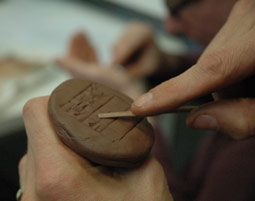Learning cuneiform signs: tips, lists, and exercises
The best way to understand the intricacies and interest of the cuneiform script is to begin to learn it, in conjuction with a little of the Akkadian language. This section offers a variety of ways to help you memorise your first 100 signs and more.

A student learning to write cuneiform at a clay tablet workshop in September 2008, sponsored by Birkbeck College, the British Institute for the Study of Iraq, and Holborn Community Development Project. Photo by Caroline Lister. View large image.
Tips for learning cuneiform signs. Make your learning interesting and effective by trying out some of these suggestions. Watch a video of a cuneiform tablet being written.
Cuneiform exercises. These pages give you manageable lists of signs to learn, lesson by lesson, with reading exercises to help you test your knowledge, and answers given separately.
Reference list of open syllables. A systematic table of over a hundred basic syllabic signs, organised phonologically. Don't learn these all at once!
Reference list of closed syllables. A systematic table of several hundred more advanced syllabic signs, organised phonologically. It's unlikely that you'll ever need all of these but it's interesting to see them all together.
Reference list of logograms and determinatives. Some of the commonest and most useful whole-word signs for nouns and verbs, and the signs used to mark word-types. You don't need to learn all these at once either!
Using sign lists and syllabaries. This website is by no means a complete introduction to cuneiform. Find out about syllabaries and sign lists in book form and on the web, and how to use them, to enable you to continue learning cuneiform to advanced level.
Content last modified on 05 Dec 2016.
Eleanor Robson
Eleanor Robson, 'Learning cuneiform signs: tips, lists, and exercises', Knowledge and Power, Higher Education Academy, 2016 [http://oracc.museum.upenn.edu/saao/knpp/cuneiformrevealed/learningsigns/]